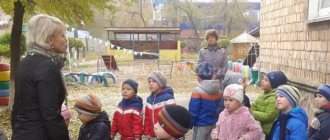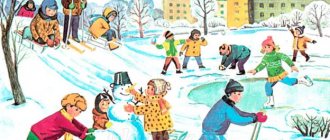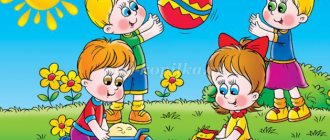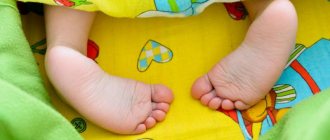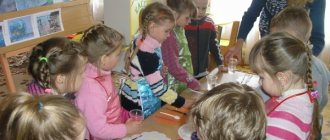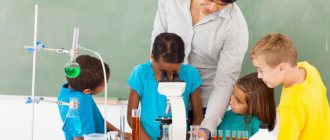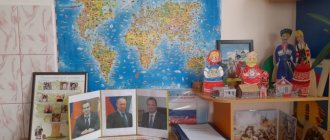Card file of walks in the preparatory group by season
The catalog of walks associated with the change of seasons is aimed at preschoolers of preparatory groups. Age-specific walks are divided into topics and involve exploring the characteristics of different seasons to form the child’s correct attitude.
Games in the winter air
Card file of winter walks in the preparatory group
Goal:
- form a set of ideas about winter changes in nature;
- teach to distinguish characteristic winter phenomena;
- direct children's interest to study natural phenomena.
Conducting observations:
- A clear winter day is suitable for a walk.
- While driving and at stops, you need to ask preschoolers to create a description of winter nature.
- Using a compass, determine which way the wind is blowing.
- What is the difference between January, February and December?
Conducting research work:
- Measuring snow depth in open areas and near trees. Children must explain why there is more snow in one place or another.
- Play the outdoor game “Stream”. Preschoolers must repeat characteristic body movements taking into account the progress of the game. Be sure to insist on compliance with the rules and order.
- Children take turns telling their favorite poem about winter. Then you should identify the characteristic signs of winter weather in the poem told.
Card index of spring walks in the preparatory group
Goal:
- form a set of ideas about spring changes in nature;
- teach to distinguish the characteristic signs of spring;
- expand previously acquired knowledge about inanimate nature through literary texts;
- direct children's interest to study the awakening of nature.
Conducting observations:
- The beginning of the walk is accompanied by a poetry competition about spring among preschoolers. Without naming the season, ask the children what time of year they are talking about based on the natural phenomena described in the poems.
- When walking in a group, be sure to focus on the obvious signs of spring that children can observe on their own.
- The observation process should affect the mechanism of formation of puddles and streams.
- What is the difference between May, March and April?
Picture of a spring walk
Conducting research work:
- Searching for the first flowers of spring. Children must describe their shape, color and features.
- Carrying out the game competition “Crow and Sparrows”. The group practices running in all directions with the development of spatial orientation.
- Intellectual exercise. Description of living nature with the obligatory guessing of a tree or flower.
Card file of autumn walks in the preparatory group
Goal:
- form a set of ideas about autumn changes in nature;
- teach to distinguish characteristic autumn changes in plants;
- expand previously acquired knowledge about inanimate nature;
- cultivate love for all living things.
Conducting observations:
- Before starting the walk, read a letter from autumn to the children inviting them to go for a walk.
- While walking, children name plants whose names they know.
- Compare the strength of the yellow and green leaves and ask the children to explain their conclusion.
- What are the main differences between October, November and September.
Signs of autumn
Conducting research work:
- Find out from children the signs of autumn changes in plants.
- Study the appearance of an autumn leaf. Why did he have dark spots?
- Explain to children the process of autumn withering and ask them to draw a conclusion about leaf fall and its causes.
- Play the game “Traps”. Preschoolers must learn to follow the rules and order when running in all directions.
- Learn to step over puddles with an explanation of the need for this.
Coloring pages on traffic rules for a preschooler 3-4 years old
Card index of summer walks in the preparatory group
Goal:
- form a generalized idea of the summer season;
- teach to distinguish weather conditions in summer;
- expand previously acquired knowledge about plants, insects and birds;
- increase children's positive perception of the beauty of summer nature.
Conducting observations:
- While walking, pay attention to the length of the summer day, the characteristics of hot weather and precipitation temperatures.
- Children characterize the process of cloud movement by their shape and color.
- Obvious signs of summer are listed, indicating what was seen during the walk.
- The life of insects is observed with an explanation of the purposes of their activities.
Summer walk for preschoolers
Conducting research work:
- Using a thermometer, you need to determine the number of degrees in an open space, in a shaded area and in a pond. Be sure to draw conclusions.
- Carrying out the intellectual game “Water Cycle”. Children listen to the text while performing certain movements in sequence. The game develops attentiveness.
- Carrying out the game competition “Crow and Sparrows”. The group practices running in all directions with the development of spatial orientation
Autumn. Work in nature on the street in a preparatory school group
Svetlana Fedoseeva
Autumn. Work in nature on the street in a preparatory school group
Autumn. Work in nature on the street, in preparatory school group No. 11.
Completed by: Fedoseeva S.N. teacher of the 1st category.
September
First week. 1. “Collecting dry leaves and branches on and near the site” Equipment: rakes, buckets and baskets, brooms and brooms.
Progress of work: start raking dry leaves with a rake, then sweep the remaining leaves with brooms, a subgroup of children puts leaves and branches in baskets.
2. “Collecting flower seeds” Equipment: container for seeds.
Progress of work: take a container, approach the flower, collect ripe seeds.
3. “Harvest” Equipment: baskets.
Progress of work: take baskets, put the harvest in the baskets.
4. “Collecting take-out material” Equipment: basket, toys.
Progress of work: take a basket, collect all the removed material.
Second week 1. “Sweep the veranda” Equipment: brooms and dustpans.
Work progress: take a broom with both hands and start sweeping into a pile, scooping garbage into a bucket.
2. “Pruning dry branches with pruning shears together with the teacher” Equipment: pruning shears, garbage bags.
Progress of work: take pruning shears, cut dry branches, fold the cut branches.
3. “Help the janitor collect dry leaves.” Equipment: rakes, brooms.
Progress of work: rake leaves into a pile, put them in garbage bags.
Third week 1. “Help children from younger groups in cleaning the territory” Equipment: baskets, rakes, brooms and brooms.
Progress of work: take equipment, go to the younger group’s area, rake leaves, put them in a basket.
2. “Collect the dug up carrots” Equipment: baskets.
Progress of work: put carrots in baskets.
3. “Collecting dry leaves and branches on and near the site” Equipment: rakes, buckets and baskets, brooms and brooms.
Progress of work: start raking dry leaves with a rake, then sweep the remaining leaves with brooms, a subgroup of children puts leaves and branches in baskets.
4. “After harvesting, tidying up the land area of the vegetable garden and flower garden.” Equipment: shovels, rakes, garbage bags.
Progress of work: take a rake to rake, then dig up the ground with shovels, put branches and debris in bags.
Fourth week 1. “Preparing the flower garden for winter” Equipment: rakes, spades.
Progress of work: take a rake, rake branches, dry grass, dig up the ground.
2. “Sweep the veranda” Equipment: brooms and dustpans.
Work progress: take a broom with both hands and start sweeping into a pile, scooping garbage into a bucket.
3. “Cleaning up the sandbox” Equipment: basket for toys.
Progress of work: take the basket, put the toys, close the sandbox with a lid.
October
First week. 1. “Planting trees and shrubs” Equipment: trees, blades.
Progress of work: bring seedlings, dig holes together with adults, plant, bury with earth.
2. “Transplanting flowering plants from a plot to a group” Equipment: flower pots, scoops.
Progress of the work: take scoops, dig up flowers, plant them in pots, cover them with soil, bring them to the group.
3. “Collecting dry leaves and branches on and near the site” Equipment: rakes, buckets and baskets, brooms and brooms.
Progress of work: start raking dry leaves with a rake, then sweep the remaining leaves with brooms, a subgroup of children puts leaves and branches in baskets.
Second week 1. “Collecting seeds of various plants to feed birds in winter” Equipment: bags.
Progress of work: take bags, collect seeds.
2. “Help the janitor collect dry leaves.” Equipment: rakes, brooms.
Progress of work: rake leaves into a pile, put them in garbage bags.
3. “Collecting leaves for making crafts” Equipment: boxes.
Progress of work: collect beautiful leaves from different trees, put them in a box.
4. “Covering seedlings for winter” Equipment: covering material, sticks and ropes.
Progress of work: insert sticks along the edges of the seedling and cover with covering material, secure with a rope.
Third week 1. “Cleaning up fallen leaves” Equipment: rakes, garbage bags.
Progress of work: take a rake, rake the leaves into a pile, put them in bags.
2. “Watering the sandbox” Equipment: watering cans.
Progress of work: take watering cans, draw water, pour sand.
3. “Planting trees and shrubs” Equipment: trees, blades.
Progress of work: bring seedlings, dig holes together with adults, plant, bury with earth.
4. “Collecting take-out material” Equipment: basket, toys.
Progress of work: take a basket, collect all the removed material.
Fourth week 1. “Hanging feeders on the territory of the kindergarten” Equipment: feeders made by children.
Progress of the work: take the feeders, tie them to the branches on the trees.
2. “Sweeping the veranda” Equipment: broom, dustpan.
Progress of work: take a broom and sweep away debris from the veranda.
3. “Collecting external material” Equipment: basket, toys.
Progress of work: take a basket, collect all the removed material.
4. “Raking leaves into piles and cleaning them up” Equipment: rakes, brooms, baskets and bags.
Progress of work: rake leaves, put them in baskets and bags.
november
First week. 1. “Raking the first snow” Equipment: shovels.
Progress of work: use shovels to rake the snow into one pile.
2. “Helping children from younger groups in cleaning the territory” Equipment: shovels.
Progress of work: take shovels, collect snow into piles.
3. “Cover bushes and trees with snow” Equipment: shovels and buckets.
Progress of work: pour snow with shovels into buckets, sprinkle snow around the trees.
4. “Sweep the veranda” Equipment: brooms, shovels.
Work progress: sweep the veranda with brooms.
Second week 1. “Cleaning up garbage on the site” Equipment: bags, brooms, dustpans.
Progress of the work: take the panicles, sweep up the remaining leaves, collect them in bags.
2. “Collecting external material” Equipment: basket, toys.
Progress of work: take a basket, collect all the removed material.
3. “Helping the janitor in clearing the area of snow” Equipment: shovels.
Progress of work: take shovels, rake snow into piles.
4. “Cover the seedlings on the territory of the kindergarten” Equipment: covering material, sticks, shovels.
Progress of work: dig sticks around the seedlings, cover with covering material, sprinkle with snow.
Third week 1. “Collecting snow in a pile to build a slide” Equipment: shovels.
Progress of work: take shovels and pour snow into a pile.
2. “Shovel snow from the veranda” Equipment: shovels, brooms.
Work progress: rake the snow with a shovel, then sweep it with a broom.
3. “Cleaning the physical education area” Equipment: shovels, brooms.
Progress of work: rake snow, sweep.
4. “Warming tree roots with snow” Equipment: shovels.
Progress of work: take shovels, pour snow around the trees.
Fourth week 1. “Collecting snow in a pile to build a slide” Equipment: shovels.
Progress of work: take shovels and pour snow into a pile.
2. “Cleaning up the area” Equipment: shovels, baskets.
Progress of work: take baskets, collect branches fallen from the wind, collect snow into the main pile.
3. “Removing snow from feeders, feeding birds” Equipment: scoops, food.
Progress of work: Use scoops to clear the snow from the feeders, pour bird food into the feeder.
4. “Clearing paths from snow” Equipment: shovels.
Progress of work: take shovels, throw snow to the sides.
Objects and topics of observation during walks in the preparatory group
On a note! Walks in the preparatory group of the file cabinet with goals for the Federal State Educational Standard should be carried out on a specific topic. The choice of topic is determined by the possibility of observing certain objects.
The location of the walk, weather conditions and additional factors also matter.
Transport observations
It is better to divide vehicle observations into several parts depending on the type of vehicle or driver actions.
- General surveillance of transport. The goal is to familiarize children with different types of cars. Preschoolers should clearly distinguish between the concepts of trucks, buses and cars. It is necessary to determine the basic functions of all modes of transport. It is necessary to distinguish the elements and parts of the car according to their intended purpose.
- Freight transport. Preschoolers name the types of trucks they know and what activities are inherent in them. The emphasis is on the functional features of the car's appearance.
- Passenger transport. What is it intended for? What is the difference between buses, trolleybuses and trams? What type of transport does a particular family use?
- Cars. What is the fuel used for? Where are the cars located when the owner is absent? What can be transported by such transport.
- Driver's job. Familiarize the group with the characteristics of the driver’s work with a mandatory positive assessment of this work.
- Traffic light operation. Which color is responsible for the different actions of a pedestrian and driver.
Observations of seasonal phenomena
The teacher organizes observation for the purpose of long-term and active perception by preschoolers of changes in nature according to the seasons.
Each season has its own characteristics:
- Autumn. As it gets colder, the teacher suggests dressing the doll according to the air temperature. On the street, children determine the temperature of living and inanimate objects by touch in sunny weather and when it is cloudy. Be sure to focus on the appearance of yellow leaves and the frequency of rain.
- Winter period. You can use the doll again. At the same time, pre-specify the low temperature so that children can dress correctly. On the street, you can take off your mittens for a short time to feel the cold. Assess with the children the level of snow cover in various parts of the kindergarten with the obligatory conclusion about what they see.
Preparatory group weather calendar
- Spring. Pay attention to the appearance of puddles and streams. You can launch a boat on the water. Children must explain how and why nature wakes up, taking into account the brightness of the sun. Monitor the air temperature. An important point is to observe the first flowers and the swelling of the buds.
- Summer. What signs characterize the summer period? Pay attention to the difference in temperature, air, water and heated inanimate objects. Why trees sway and how insects behave.
What educational areas in preschool educational institutions are provided for by the Federal State Educational Standard for Preschool Education?
Observations of the sun
Goal:
- form an idea of the beauty of the sky;
- teach to distinguish the sun's rays;
- increase children's positive perception of summer.
Carrying out observations
Assess the position of the Sun:
- Where is it in the morning?
- What is the evening location?
- Which space was illuminated better in the morning and which in the evening.
- Draw a conclusion about the length of daylight hours.
Conducting research work:
- Standing with your back to the Sun, explain the concept of shadow.
- Where is the shadow of various visible objects.
- Is it possible to chase a shadow or dance with it?
Observations of inanimate nature
Goal:
- consolidate knowledge about the various states of water;
- form the concept of inanimate nature;
- describe the signs of ice and snow.
Conducting observations:
- Why does ice turn into water when heated?
- Preschoolers name the characteristic features of ice and snow.
- Explain the water cycle in nature.
- What are the differences between snow in warm and cold weather?
Conducting research work:
- Conduct an experiment on melting large and small ice.
- Pack the snow tightly into a glass and compare the rate of its melting with a loosely collected mass of the same volume.
- Carry out finger gymnastics “Ice”.
